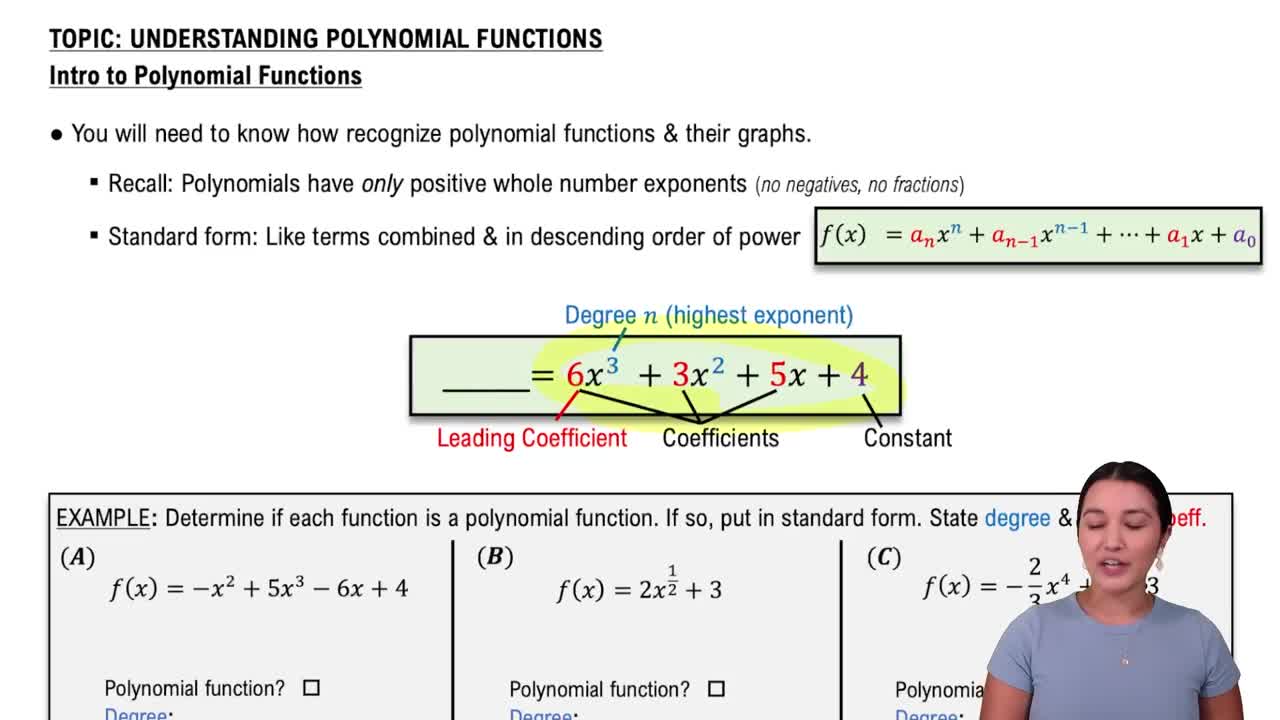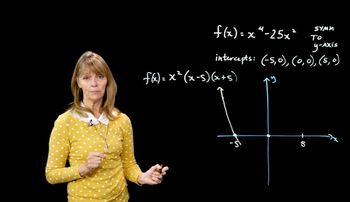Table of contents
- 0. Review of Algebra4h 16m
- 1. Equations & Inequalities3h 18m
- 2. Graphs of Equations43m
- 3. Functions2h 17m
- 4. Polynomial Functions1h 44m
- 5. Rational Functions1h 23m
- 6. Exponential & Logarithmic Functions2h 28m
- 7. Systems of Equations & Matrices4h 6m
- 8. Conic Sections2h 23m
- 9. Sequences, Series, & Induction1h 19m
- 10. Combinatorics & Probability1h 45m
4. Polynomial Functions
Dividing Polynomials
Problem 17
Textbook Question
Use synthetic division to perform each division. (1/3x^3 - 2/9x^2 + 2/27x - 1/81) / x - 1/3
 Verified step by step guidance
Verified step by step guidance1
Identify the divisor and the dividend. The divisor is \(x - \frac{1}{3}\) and the dividend is \(\frac{1}{3}x^3 - \frac{2}{9}x^2 + \frac{2}{27}x - \frac{1}{81}\).
Set up synthetic division by using the zero of the divisor, which is \(\frac{1}{3}\).
Write down the coefficients of the dividend: \(\frac{1}{3}, -\frac{2}{9}, \frac{2}{27}, -\frac{1}{81}\).
Bring down the first coefficient, \(\frac{1}{3}\), as it is.
Multiply the zero of the divisor, \(\frac{1}{3}\), by the number you just brought down, and add this result to the next coefficient. Repeat this process for each coefficient.
 Verified video answer for a similar problem:
Verified video answer for a similar problem:This video solution was recommended by our tutors as helpful for the problem above
Video duration:
6mPlay a video:
Was this helpful?
Key Concepts
Here are the essential concepts you must grasp in order to answer the question correctly.
Synthetic Division
Synthetic division is a simplified method for dividing a polynomial by a linear binomial of the form (x - c). It involves using the coefficients of the polynomial and a specific value (c) to perform the division without writing out the entire polynomial long division process. This technique is particularly useful for quickly finding polynomial quotients and remainders.
Recommended video:

Higher Powers of i
Polynomial Functions
A polynomial function is a mathematical expression involving a sum of powers in one or more variables multiplied by coefficients. In this context, the polynomial is represented as (1/3)x^3 - (2/9)x^2 + (2/27)x - (1/81), which is a cubic polynomial. Understanding the structure of polynomial functions is essential for applying synthetic division effectively.
Recommended video:

Introduction to Polynomial Functions
Remainder Theorem
The Remainder Theorem states that when a polynomial f(x) is divided by (x - c), the remainder of this division is equal to f(c). This theorem is useful in synthetic division as it allows us to quickly evaluate the polynomial at a specific point, providing insight into the behavior of the polynomial and confirming the results of the division.
Recommended video:

Higher Powers of i
Related Videos
Related Practice

